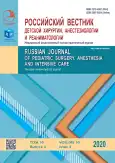Video-assisted percutaneous hernia sac suturing: a new technique of inguinal hernia repair in children
- Authors: Pavlushin P.M.1,2, Gramzin A.V.1,2, Krivosheenko N.V.2, Koinov Y.Y.2, Chikinev Y.V.1
-
Affiliations:
- Novosibirsk State Medical University
- Novosibirsk Regional Clinical Hospital
- Issue: Vol 10, No 4 (2020)
- Pages: 411-418
- Section: Original Study Articles
- URL: https://journals.rcsi.science/2219-4061/article/view/122938
- DOI: https://doi.org/10.17816/psaic704
- ID: 122938
Cite item
Full Text
Abstract
Background. Inguinal hernias are very important problem in pediatric surgery. It appears in 5–20 cases in every 1000 newborns, approximately 10 times prevalence in males. However, the incidence of inguinal hernia is bigger by 1.5–2 times in group of premature infants.
Materials and methods. In prospective study, that was performed in 2019–2020, 90 pediatric patients diagnosed inguinal hernia were included. All patients had open herniotomy (Duhamel method), subcutaneous endoscopic-assisted ligation of inguinal hernia using Tuohy needle, or video-assisted percutaneous hernial sac suturing (VIPS).
Results. The mean operating time in VIPS group was 13 ± 13.46 min in patients with unilateral inguinal hernia and 20 ± 6.12 min in patients with bilateral variant. In the 6-month follow-up period, any complications or recurrences were not observed. VIPS group included two extremely premature infant with uni- and bilateral inguinal hernia. Minimally invasive herniotomy was performed in 50 weeks post-conceptual age, with unremarkable postoperative period. A difference was found in the operating time between groups of minimally invasive herniotomy and group of Duhamel repair. No difference was found in the operating time of bilateral hernia between all groups.
Conclusion. Considered all things, assuming that announced method of video-assisted percutaneous hernial sac ligation to be a perspective minimal invasive way of treatment for inguinal hernia in children is reasonable. However, for final conclusions, further study of this surgical technique, also in a cohort of premature infants, is required, with the possible organization of multicenter clinical trials.
Full Text
##article.viewOnOriginalSite##About the authors
Pavel M. Pavlushin
Novosibirsk State Medical University; Novosibirsk Regional Clinical Hospital
Author for correspondence.
Email: pavlushinpav@mail.ru
ORCID iD: 0000-0002-6684-5423
Assistant Professor, Department of Hospital and Pediatric Surgery, Novosibirsk State Medical University, Pediatric surgeon, State Novosibirsk District Clinical Hospital
Russian Federation, Novosibirsk; NovosibirskAlexey V. Gramzin
Novosibirsk State Medical University; Novosibirsk Regional Clinical Hospital
Email: dxo26@yandex.ru
ORCID iD: 0000-0001-7338-7275
Cand. Sci. (Med.), Assistant Professor of the Department of Hospital and Pediatric Surgery, Novosibirsk State Medical University, Novosibirsk, Russia, Head of Pediatric Surgery Department, State Novosibirsk District Clinical Hospital
Russian Federation, Novosibirsk; NovosibirskNikolai V. Krivosheenko
Novosibirsk Regional Clinical Hospital
Email: dxo26@yandex.ru
ORCID iD: 0000-0001-6210-7493
Pediatric surgeon
Russian Federation, NovosibirskYuri Y. Koinov
Novosibirsk Regional Clinical Hospital
Email: dxo26@yandex.ru
ORCID iD: 0000-0002-9528-0601
Pediatric surgeon
Russian Federation, NovosibirskYuri V. Chikinev
Novosibirsk State Medical University
Email: chikinev@inbox.ru
ORCID iD: 0000-0002-6795-6678
Dr. Sci. (Med.), Professor, Head of Department, Hospital and Pediatric Surgery
Russian Federation, NovosibirskSupplementary files










